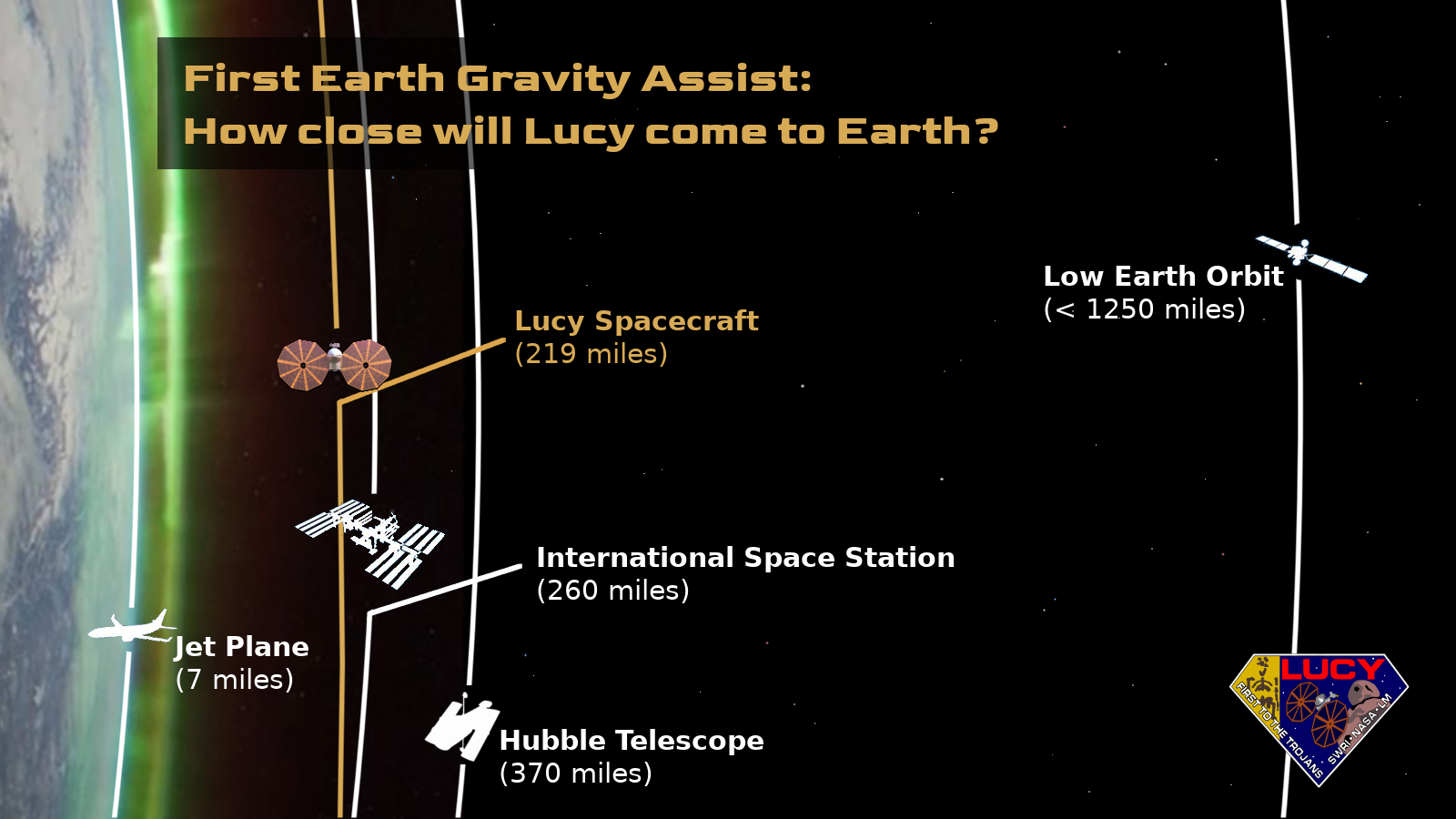First Earth Gravity Assist
Sep 29, 2022
On October 16, at 7:04am ET, NASA’s Lucy spacecraft, the first mission to the Jupiter Trojan asteroids, will skim Earth’s atmosphere, passing only about 220 miles (350 kilometers) above the surface. As the spacecraft zips by Earth on the first anniversary of its launch, it will gain some of the orbital energy it needs to travel to this never-before-explored population of asteroids.
Check to see if you will be able to see Lucy during this close Earth flyby.
Lucy is currently one year into its twelve-year voyage to explore the Trojan asteroids, asteroids that are trapped in orbits at the same distance from the Sun as Jupiter. This gravity assist will place Lucy on a two year orbit, at which time it will return to Earth for a second gravity assist. That second assist will give Lucy the energy it needs to cross the main asteroid belt and observe the asteroid DonaldJohanson, and travel into the leading Trojan asteroid swarm. There Lucy will fly past six Trojan asteroids: Eurybates and its satellite Queta, Polymele and its yet unnamed satellite, Leucus, and Orus. After that tour, Lucy will return to Earth for a third gravity assist in 2030 to increase the spacecraft’s inclination for the final rendezvous with the binary asteroid pair Patroclus/Menoetius. This is a record-breaking tour that will visit nine asteroids with a single space spacecraft.

After traveling almost 580 million miles (almost 1 billion km) in its first year in space, Lucy will approach Earth from the direction of the Sun. While this means that, upon approach, observers on Earth will not be able to see Lucy as it will be lost in the Sun’s glare, Lucy will be able to take images of the nearly full Earth and moon upon approach. These images will be used to calibrate the instruments. In this process, Lucy will attempt to take an image of Ethiopia, the location where the mission namesake, the Lucy fossil, was discovered.
Lucy’s trajectory will bring the spacecraft deep into near Earth orbit, lower even than the international space station. This means that Lucy will pass through a region full of earth-orbiting satellites and debris. In order to ensure the safety of the spacecraft as it flies through this area NASA has procedures to anticipate any potential collision and, if needed, execute a small maneuver to avoid a collision. This trajectory correction maneuver would only alter the time of closest approach by 2 or 4 seconds, but that is enough to avoid a catastrophic collision with the spacecraft.

At around 10:55 UTC, 6:55pm local time, Lucy will first be visible to observers on the ground in Western Australia. Lucy will quickly pass overhead, clearly visible to the naked eye before disappearing at 11:02 UTC (7:02pm local) as the spacecraft passes into the Earth’s shadow. Lucy will continue over the pacific ocean in darkness and emerge from the Earth’s shadow at 4:26am PT (11:26 UTC). If the clouds cooperate, sky watchers in the western United States should be able to get a view of Lucy with the aid of binoculars.
Lucy will then rapidly retreat from the Earth, passing behind the moon and taking a few more calibration images before continuing out into interplanetary space.
We invite the public to join our #WaveToLucy social media campaign by posting images of themselves waving towards the spacecraft and tagging the mission account in their posts on Twitter, Facebook or Instagram. Upon approach you won’t be able to see the spacecraft, but if you look towards the direction of the Sun (don’t look directly at the Sun!) Lucy will be looking towards you!
Additionally, if you are in an area where Lucy will be visible, in addition to giving a #WaveToLucy, we encourage you to take a photograph or video of Lucy and post it to social media with the #SpotTheSpacecraft tag. Head here to see how you might be able to watch Lucy from your location!
